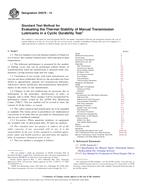We need your consent to use the individual data so that you can see information about your interests, among other things. Click "OK" to give your consent.
ASTM D4693-07(2012)
Standard Test Method for Low-Temperature Torque of Grease-Lubricated Wheel Bearings
STANDARD published on 15.4.2012
The information about the standard:
Designation standards: ASTM D4693-07(2012)
Note: WITHDRAWN
Publication date standards: 15.4.2012
SKU: NS-28187
The number of pages: 8
Approximate weight : 24 g (0.05 lbs)
Country: American technical standard
Category: Technical standards ASTM
The category - similar standards:
Annotation of standard text ASTM D4693-07(2012) :
Keywords:
low temperature torque, lubricating grease, wheel bearing grease, Automotive wheel bearings, Calibration--petroleum analysis instrumentation, Lubricating grease, Rotation testing, Strain testing, Temperature tests--petroleum products, Torque--petroleum materials/applications, Viscosity--petroleum products, ICS Number Code 75.100 (Lubricants, industrial oils and related products)
Additional information
| Significance and Use | ||||||||||||||||||||||||||
|
This test method differentiates among greases having distinctly different low-temperature characteristics. This test is used for specification purposes and correlates with its precursor which has been used to predict the performance of greases in automotive wheel bearings in low-temperature service. It is the responsibility of the user to determine the correlation with other types of service. |
||||||||||||||||||||||||||
| 1. Scope | ||||||||||||||||||||||||||
|
1.1 This test method covers the determination of the extent to which a test grease retards the rotation of a specially-manufactured, spring-loaded, automotive-type wheel bearing assembly when subjected to low temperatures. Torque values, calculated from restraining-force determinations, are a measure of the viscous resistance of the grease. This test method was developed with greases giving torques of less than 35 N·m at −40°C. 1.2 The values stated in SI units are to be regarded as standard. No other units of measurement are included in this standard. 1.3 WARNINGMercury has been designated by many regulatory agencies as a hazardous material that can cause central nervous system, kidney and liver damage. Mercury, or its vapor, may be hazardous to health and corrosive to materials. Caution should be taken when handling mercury and mercury containing products. See the applicable product Material Safety Data Sheet (MSDS) for details and EPA’s websitehttp://www.epa.gov/mercury/faq.htmfor additional information. Users should be aware that selling mercury and/or mercury containing products into your state or country may be prohibited by law. 1.4 This standard does not purport to address all of the safety concerns, if any, associated with its use. It is the responsibility of the user of this standard to establish appropriate safety and health practices and determine the applicability of regulatory limitations prior to use. |
||||||||||||||||||||||||||
| 2. Referenced Documents | ||||||||||||||||||||||||||
|
Similar standards:
Historical
1.10.2010
Historical
1.6.2014
Historical
1.5.2014
Historical
1.5.2011
Historical
15.4.2009
Historical
1.5.2014
We recommend:
Technical standards updating
Do you want to make sure you use only the valid technical standards?
We can offer you a solution which will provide you a monthly overview concerning the updating of standards which you use.
Would you like to know more? Look at this page.



 ASTM D5483-05(2010)..
ASTM D5483-05(2010).. ASTM D5505-14
ASTM D5505-14 ASTM D5579-14
ASTM D5579-14 ASTM D5619-00(2011)..
ASTM D5619-00(2011).. ASTM D566-02(2009)..
ASTM D566-02(2009).. ASTM D5704-14
ASTM D5704-14
 Cookies
Cookies
